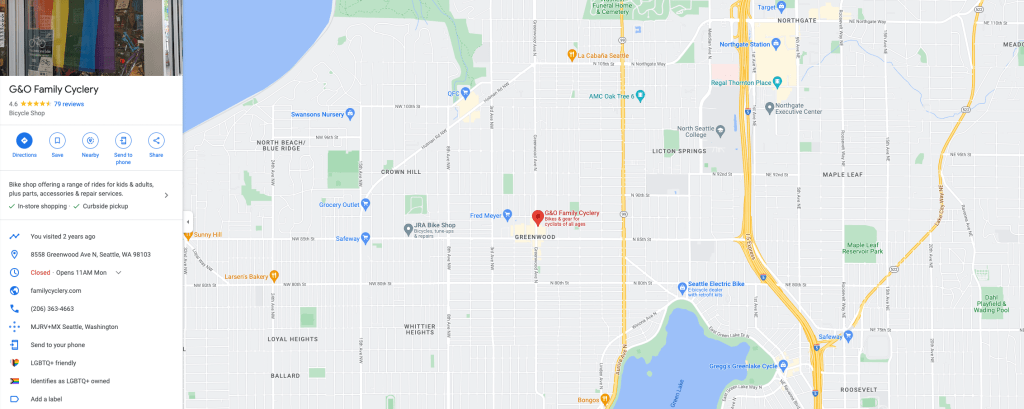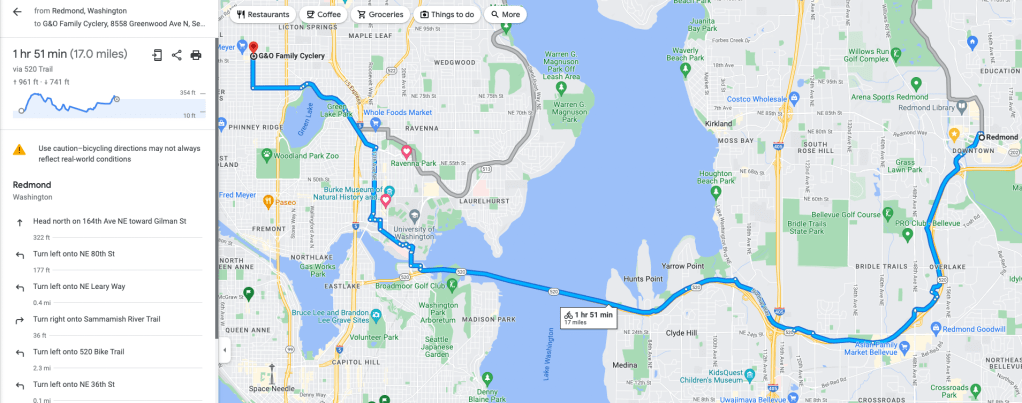If you’re curious about my other rides, I’ve written up a few posts about them under my “All-City Pop Rocket” and “Space Horse Disc“. Today’s post is about the Riese & Müller Load 75 Electric Cargo Bike and the adventures we’ve gone on so far! If you’re curious about the exact specs, I’ll have those at the very end of this post. For now, I introduce to you my Riese and Müller Load 75, AKA “Reload“.
Day 1 – Pick Up @ G & O
The first day involved pick up. I only mention this because it wasn’t merely a “go in store, buy bike, take home” type of scenario. With one of these bikes amidst these modern day supply challenges, combined with America’s inferior transportation systems and draconian take on anything but automobile travel, these bikes are kind of hard to get. So on day 1, at pick up, I’d already purchased and waited through shipping from Germany and the final assembly of the bike here in the USA. That’s where I’m happy to highly recommend G & O Family Cyclery in Seattle.
G & O Family Cyclery is a shop that focuses on bikes for people with families, like me, that want to have the extra advantage of a powered bicycle (or non-electric if you want to give that a go, but this is Seattle, land of hills and mountains!) or replace a car outright. In my case, I have no car to replace, so this is merely an addition that my son can ride in or I can just run errands and pick up metric tons of pizzas for game night! Whatever your reason for wanting an electric family focused bike, G & O Family Cyclery is your place in Seattle for the premium options.

Once I had made this decision and purchased the bike, it started it’s route from Darnstadt, Germany to Seattle, Washington, USA. This took well over a month and into the 6+ weeks time frame. To note, I also ordered a bike that was basically ready to be shipped too, another that is ordered custom and still has to be made ready to ship could easily take another 2-4 weeks or more depending on the build queue. Needless to say, if you want a high quality, durable, and capable e-bike of this caliber then you’ll likely have to wait a bit for it to arrive.
Once it arrived G & O assembled the bike and added various accoutrements to the bike. I didn’t get just the base bike, which I’ve included a picture of here for reference of what the “base” bike looks like.

The base cargo bike itself is extremely smooth riding, powerful, with one of the more (most?) powerful electric motors from a torque perspective on the market. Which, when you live in a place like I do that torque is crazy important to get up the hills! But I didn’t just purchase the basic bike because I wanted more flexibility. Some of the things I wanted to be able to do with this bike includes:
- The ability to pick up food from town, about 1-2 miles away, in the heart of Redmond. Then return with that food while it’s still hot and fresh. Not a single soggy ass hamburger will be allowed, not a single dried out set of soup dumplings, not a single cold kebab!
- The ability to safely carry a child with seat belts to keep em’ in the bay, with protection from the wind and rain, because again, I do live in Redmond, Washington where it rains about 8 months of the year!
- The ability to load up for outdoor expeditions that trek at least 20+ miles out into the woods in one direction. Then be able to trek back from that location without needing a recharge!
- The ability to get into and out of Seattle from way over here in the boonies of Redmond, without using any mode but the bike and without requiring a recharge. In addition, while in Seattle I’d need at least 10-20 miles worth of charge to run errands, pick up equipment, tools, or other things like 1U, 2U, or 4U Rack Servers since I’m a hardware nerd and I pick up things like that sometimes. For those not versed, that’s about 20-80 lbs (9-36 kilograms) of metal computer gear that is about 2-3 feet long (0.6-1 meter deep from the rack perspective) and ~2 foot wide (0.6 meters) and a few inches tall (7-8 cm).
- The ability to carry a keg. Not that I’d likely be doing that because these days I generally just fill a growler if I’m going to carry a quantity of beer somewhere or buy a bunch of singles. Which, in that case this bike would also need to carry 24-36 bottles of beer or wine as smoothly as possible so they don’t break.
- The ability to carry a propane tank for things like a grill. Ya know, cuz sometimes ya gotta cook veggies for the vegans AND you want to whip out some wicked steaks on the grill. Propane is pretty wicked efficient for that!
- Carry 1-2 guitars and a 2×12″ Amp. Weighing in at a solid 100-140 lbs (45-64 kilograms).
That rounds out the tasks this bike needs to achieve for me on a daily basis, so when I ordered it I bumped up the gear, which Riese and Müller are of course more than prepared for! To ensure that this bike would be able to accomplish every single one of those goals I consulted with the G & O Cyclery Crew and they put together a build for me that included the following:
Low Side Walls & Child Cover, along with three child seats (albeit I’ve not got three kids, but YOLO!), footwell, and a luggage shelf for the kiddo.


This took care of several of the tasks, almost 90% of the need around food pick up, and carrying an amp and a guitar in a hardshell case. All those things were check, check, and checked!
There were a few more amenities needed to really round out things and ensure that not 90% of the need was fulfilled but 100% of the need. That included a rear carrier rack, additional lock chain and bag for the lock chain, multicharger, and upgrading form single battery to dual battery! With those additions every single one of those tasks is now met, and beyond day 1 I’ll be providing some coverage right here about the Load 75 adventures!
We come full circle now with full context of new bike pick up day! What did new bike pick up day at G & O Family Cyclery consist of? Well, Davey Oil (Jenna and the rest of the crew that had been helping me pick this out where there too! Hey y’all! 👋🏻) gave a run down of all the bike gear, battery system, engineering, and coverage of maintenance and check ups for the bike. He didn’t just spit it all out to me as an unknown quantity either like happens sometimes in bike shops, he discussed with me my own experience with bikes, took into account that I basically have a bike shop of gear to work on bikes with, albeit often don’t have time to. He also took into account after a little discussion, that I’ve been riding and been car-free – i.e. only used a bike for my primary transportation for over a decade – and then went over those topics.
Davey going over these things with me before going over all of these things allowed him to specifically cater what details I could really use, was able to answer specific questions I had, and really set me up for successful usage of the bike! The TLDR, I was impressed and I’m not usually impressed very often.
With that, day 1 was complete and I set out from G & O for that 17 mile ride back home to Redmond, Washington!

For more details on the bikes that G & O Family Cyclery offer check out their site here or even check out this specific bike here.
Now for those promised specs for the spec nerds out there! Enjoy! 🤘🏻
Gear Specifications
Rear shock X-Fusion Glyde
Headset Acros AZX-221, block lock; TH No. 9, semi-integrated
Seatpost JD/Riese & Müller, Alu, 34,9 x 430mm
Seat clamp TranzX, 40,0 mm, QR
Tubes Schwalbe AV13; Schwalbe AV7
Rims Alex MD30 26″; Alex MD30, 20″
Front hub Novatec Disc 32H
Rear hub Enviolo 380, 36H
Battery DualBattery 1000
Motor Cargo Line Cruise (Gen4)
Display Nyon
Crankset FSA/Riese & Müller, 170 mm
Chain ring 55T, for Gates drive belt CDX
Chain guard Belt guard
Chain Gates drive belt CDX
Pinion 22T, for Gates drive belt CDX
Saddle Selle Royal New Lookin Evo R&M
Pedals VP R&M Custom
Shifter Enviolo grip shift Twist Display Pure, continuous
Handlebar FSA V-Drive, 31,8 mm, Alu
Stem Riese & Müller, adjustable height and angle
Grips Ergon ergonomic
Brakes Tektro TRP C 2.3 disc brake
Front light Supernova M99 Mini Pro-25
Tail light Supernova M99, integrated brake light
Mudguards SKS A65R
Frame colour coal grey matt
Suspension fork SR Suntour Mobie A32, 20″, 50mm
Tires Schwalbe Big Ben Plus 55-406 Reflex; Schwalbe Big Ben Plus 55-559 Reflex; Schwalbe Smart Sam Plus 57-559 Reflex*; Schwalbe Smart Sam Plus 60-406 Reflex*
Rubber Bibia*
Bell Billy
Luggage rack Riese & Müller*
Ständer Kickstand Riese & Müller
Lock Additional chain lock with bag
RX Hardware RX Chip (für RX Services)*
